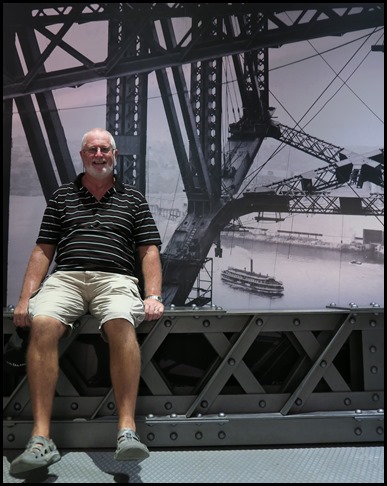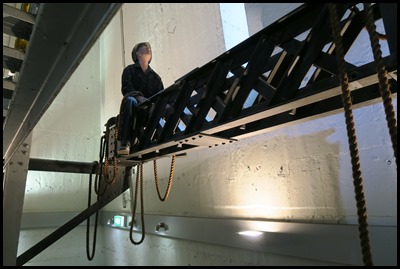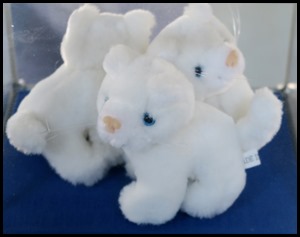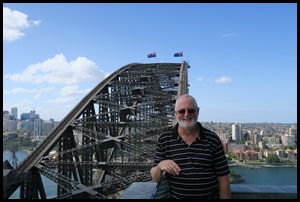SHB Pylon 2

Beez Neez now Chy Whella
Big Bear and Pepe Millard
Sat 27 Feb 2016 23:57
|
Sydney Harbour Bridge Pylon Visit –
Up to the Top Level
 We left the middle level with the
model of a rivet being heated in the
oven.
 My bridge
man.
  Up the next lot of steps. This pylon
staircase was built during the construction of the Sydney Harbour Bridge. The
cantilevered structure and the figures added in 2003 demonstrate how the bridge
was built. We looked at a model of a worker and then
down on him as we rose.
   Very dodgy dangling at great height in
a pair of boots on a rope.
 At the top of the next set of steps was another
shop.
 The grand opening,
a big picture on the next half turn of
steps.
    Memorabilia in display cases.
 Ceremonial scissors were used by the
Premier of New South Wales J.T. Lang to open the Sydney Harbour Bridge in 1932.
This replica was produced by Angus and Coote. The scissors were designed by Vambola Veinberg, Les Denham
embossed them and Norm Neal engraved them in Angus and Coote’s workrooms. The
scissors were made of Australian gold, hand-wrought with flannel flowers,
waratahs and gum leaves set with six flame-coloured opals around a model of the
bridge.
 Australians greeted the opening of
the bridge on the 19th of March 1932 with an outpouring of patriotism and pride.
Economic depression was momentarily forgotten as the birth of the largest steel
arch bridge in the world was celebrated in style.
Enraged that Premier J.T. Lang had been chosen to open the bridge,
ex-army officer F. De Groot, a member of a
disgruntled paramilitary group slashed the ribbon minutes before the opening
ceremony. De Groot was arrested and fined five pounds – later he appealed and
was given expenses........and a place in Australian folklore. At the time, the
ribbon was quickly repaired and on things went......
After official speeches and
ribbon-cutting, a two kilometre long procession flowed over the bridge.
Decorative floats, marching bands, school children, WWI veterans, Scouts,
Aboriginals and Harbour Bridge workers all played a part in the long parade.
Hundreds of thousands of people attended the opening day celebrations, which
were triumphantly broadcast throughout Australia, Great Britain and North
America.
 Finally at the top we found another load of information, this time in bits and
bobs.
 Photograph taken in
1931.
   The Pylon Lookout has had a long and
eventful history as a national and international tourist attraction. In 1934 an
enterprising businessman called Archer Whitford converted the pylon into a
popular tourist attraction. Attractions included a camera obscura, an Aboriginal
Museum, a Supreme Cafe, a ‘Mother’s Nook’ [a place to write dutiful letters
home] and a ‘pashometer’ on which visitors could measure their sex
appeal.......... At the viewing platform a host of ‘charming
attendants’ assisted visitors to use the telescope on offer. During World War Two all such activities abruptly ceased. The
four Harbour Bridge pylons were taken over by the military and modified to
include parapets and anti-aircraft guns.
From 1948 to 1971, the ‘All
Australian Exhibition’ aimed to turn the south-east pylon into a ‘showcase for
Australia’. Financed by government departments and private and public companies,
it consisted of informative dioramas and displays on subjects such as farming,
sport, transport, mining, banking, the Navy and the Air Force. Visitors could
enjoy the viewing platform using an orientation table, a scenic wall guide and
giant binoculars.
White cats
resident in the roof-top cattery were another popular attraction, especially as
they had their own cat-merry-go-round.... These belonged to exhibition manager
Yvonne Rentoul, who also ran a souvenir shop and postal outlet from the pylon.
Mrs. Rentoul’s lease expired in 1971 and for the next decade the Pylon Lookout
was not open to the public.
In 1982 the Pylon re-opened, the
occasion being an exhibition marking the Bridge’s 50th Anniversary. The pylon
housed a Bicentennial exhibition from 1987 to 2000, and the Proud Arch Landmark
Exhibition from 2000 to 2003.
          Bear’s favourite factoid is that
there were only five cars registered in Sydney when building began, a very
forward thinking planning team decided on six car lanes, two tram, two
pedestrian and two train lines. When the trams were withdrawn from service these
lanes were converted to traffic, bringing the today to eight vehicle
lanes.
           Our memories and the views from the top.
         ALL IN ALL AN INSPIRING
BUSINESS
GREAT
VIEWS |